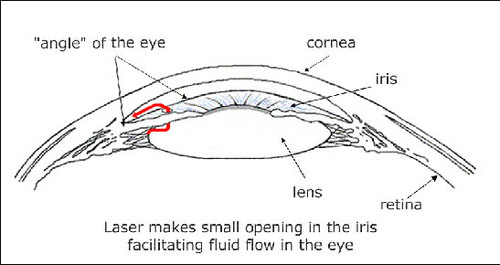|
|
 |
 |
 |
 |
|
|
Glaucoma Laser Treatment: Laser Peripheral Iridotomy (LPI)
|
Printer Friendly
|



Teresa C. Chen, MD Massachusetts Eye and Ear Infirmary, Harvard Medical School January 13, 2003
|
When is LPI indicated?
Laser peripheral iridotomy is generally recommended for patients with narrow angles, narrow angle glaucoma, or acute angle closure glaucoma. When LPI is used in patients with narrow angles, it is considered to be a prophylactic procedure that prevents these patients FROM developing acute angle closure glaucoma, which they are at higher risk of developing. This is significant in that an acute attack of angle closure glaucoma usually presents with high eye pressures, pain, and loss of vision. When LPI is used in the treatment of patients who already have acute angle closure glaucoma, it is used to help lower the pressure as well as to prevent another attack of angle closure glaucoma.
What is LPI?
LPI attempts to "open" a "narrow" angle. Since the angle is the part of the eye that drains fluid FROM the eye, narrowing of the angle can put the eye at risk for an acute attack of angle closure glaucoma. During the LPI, a laser is used to make a small opening in the peripheral iris (the colored part of the eye). This changes the fluid dynamics in the eye and "opens" the angle. If a patient already has acute angle closure glaucoma, the small opening that is made in the peripheral iris allows fluid to drain more normally and also lowers the eye pressure.
Figure 1
If I am HAVING the LPI for preventing an acute attack of angle closure glaucoma, will this lower my eye pressure or improve my vision?
No, the LPI will not improve your vision or lower your eye pressure. It will only try to prevent your eye FROM developing an acute attack of angle closure glaucoma.
If I am HAVING the LPI for treatment of an acute attack of angle closure glaucoma, will this lower my eye pressure and improve my vision?
In general, the LPI will help to lower your eye pressure which may then lead to improvement of your vision. The amount of eye pressure lowering and the degree to which your vision will improve depends on the severity and duration of your acute attack of angle closure glaucoma. Sometimes, other medications or even glaucoma filtration surgery may be needed to ultimately control the eye pressure.
What should I expect if I have a laser iridotomy?
The procedure is an outpatient procedure that can usually be done in the eye doctor's office. You are seated at a slit lamp with your forehead resting against a headpiece and your chin resting in a chinrest. After some eye drops are put in the eye in ORDER to numb the eye, a lens will be placed on your eye. This will prevent you FROM blinking and will also minimize your eye movements. The lens also helps to direct the laser light INTO your eye. The laser, which is attached to the slit lamp equipment, is then directed INTO the eye. The procedure usually takes a few minutes. Most people experience minimal discomfort during the procedure. After the laser, you may experience some irritation in the eye and some blurry vision, but this is largely resolved after a day or two. You will usually have your eye pressure checked one hour after the laser procedure. You are then usually seen the day after the laser procedure and/or the following week. The number and frequency of visits after the laser may vary and depend on the condition of your eye. Most people will need to be on an eye DROP four times a day for one week to help the eye heal FROM the laser.
What are some risks of laser surgery?
All laser procedures have some risks. Laser treatment is not done unless the benefits outweigh the risks. Risks include, but are not limited to, bleeding, inflammation, eye pressure elevations, and even vision loss. In general, serious risks are not common, however, you may want to discuss the benefits and risks with your doctor should you have any further questions. | |
 Figure 1
Figure 1
|
|
|
The information and recommendations appearing on these pages
are informational only and is not intended to be a basis for diagnosis, treatment
or any other clinical application. For specific information concerning your personal
medical condition, the DJO suggests that you consult your physician.
|
|
 |
 |
 |

|
|
 Welcome, please sign in
Welcome, please sign in  Welcome, please sign in
Welcome, please sign in